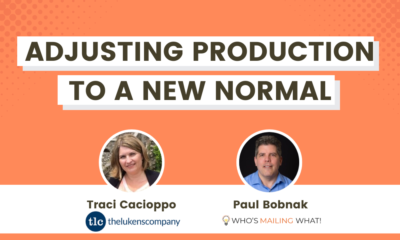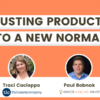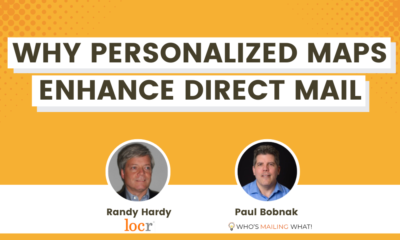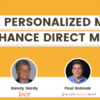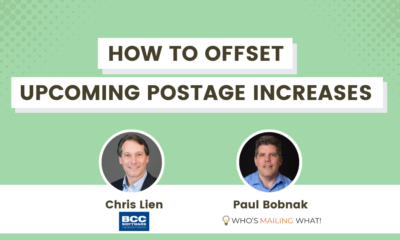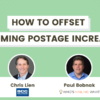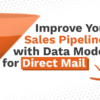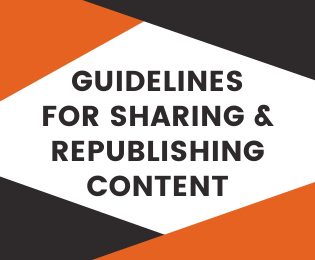MEET THE MAILERS
Meet the Mailers: Creative & Data Working Together in Direct Mail
In this episode, we talked with two leaders from Darwill about how creative and data work together to drive response.
In this episode, I talked with two leaders from Darwill: Mark DeBoer, Senior Vice President of Sales, and Kim Pannos, Creative Director. Based in Hillside, IL, Darwill is a full-service, national, integrated marketing company bringing proven direct marketing solutions for companies of all sizes.
As long-time pros in the direct mail business (and working for Darwill), Mark and Kim spent part of the discussion talking about how creative and data work together to drive response:
You could have the best creative in the world, the best message in the world, and the best offer in the world. But if it didn’t get there, it was worthless.
 Mark DeBoerSr Vice President of Sales
Mark DeBoerSr Vice President of Sales
Darwill
Among the many topics we covered:
- Darwill’s services to marketers
- Kim & Mark’s backgrounds
- Targeting prospects based on online behavior
- The effect of postage and paper increases
- Why direct mail works
- Trends in direct mail marketing
Here are some questions and answers (edited for clarity and space):
- What types of services does the company offer to marketers?
We’re traditionally a direct mail partner with our partners, so we work with companies in their marketing departments directly. We also are a partner with other people who maybe like an agency or something like that where they’ve got a different kind of a relationship where we help kinda augment and support them.
But traditionally all of our pieces are mailed to somebody, or it’s a direct targeted message delivered because we not only do just print, we’re also doing digital as well. But I think the way that we summarize it is [that] we kind of start with the data. We have a full suite of data analysts that can help us start with that, and then we figure out how to best market to people delivering the best ROI with whatever the case may be
- Let’s talk about the role of creative in direct mail. Why is it so important to a marketer’s strategy?
Kim: I’ll take that one. So creative – you need it to send out the mail. But I think when Darwill, and we’re working with the client, creating for them, we’re not just looking for a branding piece, we’re not just looking to get somebody’s name out there. We want this mail to evoke a response out of the recipient. So sometimes we take tactics that aren’t, you know, the prettiest … We are doing things that direct people to take one single action. So the creative of the direct mail may be something that the marketing department is not used to.
But since the team here has been in direct mail for so many years and we work on thousands of clients and campaigns over a year’s time, we’ve kind of come to know the importance of the different pieces of direct mail campaign that can drive that response.
Whether it be not reversing out the single call to action because people’s eyes aren’t trained that way [or] keeping line lengths to a certain degree of characters, it’s easier for somebody to read and get through. Those are things that your creative or agency should be taking into account when working on mail campaigns. Cause mail’s been around for a long time. If you’re doing it right, you’re tracking it, and you’re learning a lot from it each time to continue and make improvements to your campaigns.
Mark: Because we deal with so many different verticals, there’s a lot of learnings that we can get from one vertical that is transferable to another, and there are times when we try something and go “that didn’t work”. But you have to measure it. You have to measure the creative along with the data and the delivery methods, whether it’s mail or digital, like you have to always be measuring to figure out what works.
You know, there are so many things you could do from a creative standpoint [and] data standpoint that we’re always testing something. We just have to usually pull the reins back and go, “don’t test everything all at once.”
Kim: No. You can’t throw the whole kitchen sink at the wall. And find any learnings. But also, I think because of the sophistication of the data and working with an agency that knows how to work that into the creative is going to help and get you a stronger piece. We’ve been putting first names and personalization on pieces, but now we can take it a little further and target people with the right type of imagery, talk to a single-family household versus a couple or a family, and those things kind of just make the creative and the campaign more appealing to the end reader.
And I think you do have to have a specific hierarchy to work somebody through a direct mail campaign, which is very important. And then when you have all these other digital avenues, whether it be something as simple as Informed Delivery or Facebook targeting ads, that you’re kind of getting the same call-to-action.
You’re the same feel, the same look. So that brand representation is there, but also that, “Oh, I saw that they were offering 20% off of, so, I didn’t do that yet. I wanna do that now that I’ve seen this secondary digital ad”. But it feels familiar because all the pieces are working together and not against each other in silos.
- So let’s talk about some specific ways that marketers can use the power of print and all the capabilities to get the most from design.
Kim: So just that influx of the technology of all of our different printing solutions and what’s available to us along with that data paired together is what’s really driving the pieces now and making them dynamic and direct one-to-one, to that one person opening their mailbox.
You know, before when I started, great – you could print digitally and you might be able to throw in a big headline with somebody’s name in it which caught their attention – maybe. But now we’re kind of taking that even further. We can do things like show somebody a map of how far away your home is to the nearest location.
We can show pictures of their property if we’re serving a real estate piece or a refinancing mortgage type of piece. There are a lot of ways to speak to what we know from data to that person. It also kind of is good with the different touches in a customer’s journey. They may be doing things online or in our client CRM, kind of letting us talk to them more directly and where they’re at.
Whether it be a past purchaser, somebody who’s come to your site that hasn’t purchased – all those data points are getting collected and we can make kind of paths for each of those people in the funnel.
Mark: I think the other thing that we’re seeing more and more of is I think traditionally if you look at customers who have like a direct mail silo and then they have their digital group, SEO, pay per click, whatever it might be on the digital world … sometimes those worlds aren’t always talking to each other.
Like they’re all working off of a brand standard that may be given to them by an agency or something like that. But when those messages come out, there’s not always this usage of the data in both the silos so that when a person got a direct mail piece, they should get a digital ad a few days after or a few days before it hit their mailbox and then continue to hit them before or after.
But just have a cohesive strategy with these multiple different methods of delivering the information, which I think that’s where we see the biggest convergence happening, is using that data that we have to know that we just hit Paul on Tuesday with an offer. On Wednesday, I’m gonna serve him up with this in the email say, or something very basic, and then maybe hit ’em with the display ad five times after that. And it all looks the same.
It’s strategically timed, and I think that’s a lot of what we’re doing now. To really just drive the power of what that print does is getting that attention because everybody sees it.
But I still like it … everybody gets their mail and has to do something with it. I can’t just like grab it and just dump it into the recycling bin as I’m walking back into my house. So, I think that’s where the power of print just is, that even if it’s a quick capture, it’s something.
Kim: We start mail, but we keep going and get in all these other places like Mark said. So that might be the first time you see us. And because you took those steps to the mailbox, you kind of committed it to your memory, but now all of a sudden you’re seeing us on your streaming video ads or on your social feeds just keeping that going.
- Let’s go off on a little bit of a different tangent and talk about postage and paper increases. We know that it’s been on the minds of everybody. How has that affected mail design as well as a strategy?
Mark: Yeah, that’s a good question. It’s obviously very timely. It’s gonna be timely for us, every six months delivered into the future, whatever that may be. So, as we think about that, I don’t know that necessarily the design changes as much as being smart about the data becomes of the utmost importance … [I]n the attention-capturing you get with the direct mail piece driving, maybe some other supporting channels of digital where it’s low-cost delivery, where maybe on its own that digital channel just gets lost or there’s, you know, it’s cheap and everybody goes, “Oh, we spend a ton on digital, but it’s all cheap, right? So it’s cheap and that’s why I do it.” Well, if it’s cheap and ineffective, then what’s the point of using it anyways?
[S]ometimes you might have to spend a little bit more money. So postage goes up, paper goes up, and whatever it might be, you have to look at the ROI on it and go, “OK, what kind of a lift do I get when I maybe add some other lower-cost touches to maybe just boost the lift?” So I think it’s getting strategic with the data and then breaking down those two silos like I talked about, where you have to have the DM and the digital strategies very, very tight with each other, pointing back to what data do we have and what can we market to, and kind of see what kind of a lift, and measuring to see what’s happening.Kim: Not wasting, you know, any of your budget by targeting people who aren’t going to respond. I think that’s where kind of our data science team shines, is helping us model and understanding who we should be targeting.
- So let’s get back to something we touched on earlier, which is convergence and omnichannel marketing. How can direct mail really work best with other channels?
Kim: Well, I think if you’re working with the right agency and they are using model data across the board, not just for mail, then they can continue to use it in those other channels … you’re already putting yourself in a good spot because then you do know you’re not targeting John over here, but Sam over here. And it’s the same message, but not the same person getting it.
The other thing is that a true omnichannel experience isn’t just that I saw these ads in three places. It’s that I saw the same kind of call-to-action, ask, offer, messaging in those multiple places. So when you have all your marketing work coming out of the same place, you’re able to control that a lot more and make sure you are putting out a cohesive message. And also when you’re testing and learning, then you can also pivot cohesively and not have those outliers out there.
Mark: I think we’re definitely seeing customers who are very sophisticated and well down the whole customer journey, communication roadmap and others are, “Yeah, we should probably have this thing that tells us like what we should be saying to people as they become a customer of ours, or as we’re trying to get them, what are we offering?”
[W]e have such a convergence of people who get it and people who are still [in] infancy stage. It’s kinda like .. when we first brought out the first digital presses where people were like, “Wait a second, so you can change the whole sheet at one time? How does that print look? Is it gonna match like what I’m seeing on a press?”And we had to kind of talk through those differences and we’re kind of at that same kind of an impasse of like, “Okay, well we gotta get there.” So how do we all feel real comfortable about building a communication roadmap and being real clear on how to lay it out, sell it to whoever needs to sign off on it and then execute it without it being like a ton of work for somebody to have to do.
Because if it’s not done well and efficiently well, it’s now it starts to get expensive, and we’re trying to keep that as seamless as possible, which is I think what our big focus is in on: Start the data, build the creative out of that and drive all these things that happen because we have a plan. And once you have that plan set, it just kind of happens.
So some of that takes commitment to not just like turn it on, turn it off. You have to be committed to “we’re gonna struggle through what this might look like, and we’re gonna measure along the way to figure out where are we winning and how do we keep on winning in doing more of the same or tweak it to be better”.
- [I]n a similar vein, how can direct mail be sent to prospects based on their online behavior?
Mark: [W]e do a couple things where we’re doing some geotargeting types of efforts tracking somebody’s mobile activity and figuring out what that IP address might be linked to, and then mailing them a piece.
So, we have a program called Rapid Retargeting where somebody visits your website, abandons a shopping cart, browses something and takes off, doesn’t do the next thing you want them to do. We are capturing that IP address and then mailing them out a First Class postage piece the next day so that we’re capturing them within a five-day window.
I guess with now Delivering for America, maybe it’s five to seven days but still First Class, right? And we’re doing our best to keep the thought fresh while my online experience triggered something that’s now going to allow me to market to that person. We’re building programs that allow for us to do that as well.
And we’ve got a platform that allows us, if somebody’s got 25 people a day, it’s not a bank buster because we have a system that collects them and runs it, and we can kind of measure that for these people along the way.
Here is our conversation. We’ve added timecodes for your convenience.
Thanks very much, Mark and Kim, for a really interesting and informative chat! To learn more about Darwill, visit their website at Darwill.com.
Your comments and ideas are very important to us in making your Who’s Mailing What! experience even better for you. Through these engaging and informative talks, we hope you’ll take away practical tips, insights, and stories to inspire and build your own success.
If you have any feedback — or are interested in sharing your expertise and viewpoint with our wide and diverse audience on “Meet the Mailers” — please reach out to me. I’d love to hear from you!









